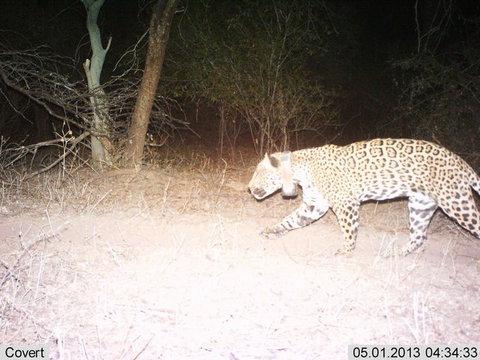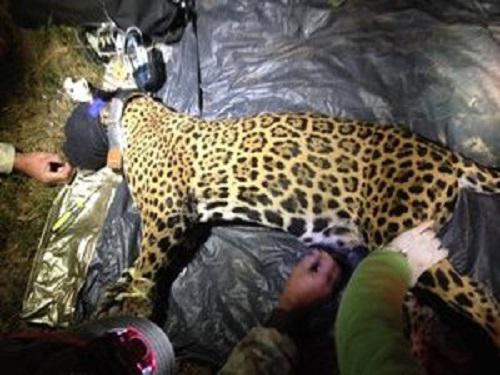Ivonne Cassaigne Guasco
Determine the impacts of the augmentation of relative abundances of the main prey (peccary and deer) of apex carnivores (pumas and jaguars) on livestock predation.

Male jaguar with collar on camera trap.
Cattle predation by mountain lions (Puma concolor) and jaguars (Panthera onca) has provoked conflicts with cattle owners that end in most of the cases with the killing of the predator. Many factors contribute to livestock predation, but two of the apparently most important are the low availability of natural prey and poor cattle management practices. In response to a group of private ranchers request and concern on livestock predation but also on conservation of the predators, this project was launched, as an experimental alternative to reduce livestock predation.

Female jaguar.
Based on a review of camera trap photos from the project area, during the period 2008-10, peccary populations, which are considered a main prey for jaguars and pumas, were considered to be extremely low when their detection rates were compared to other prey items and to other similar camera trap studies going on in southern Arizona. Restoring peccary population and increasing relative abundance of deer, which had also been found in lower numbers than in adjacent areas with no cattle, will allow us to determine the impact of natural prey availability on livestock predation by pumas and jaguars.
We will identify jaguar and puma densities by DNA studies. Place satellite collars in 5 top predators (jaguars and pumas) in order to directly investigate kill sites and establish rates of predation from livestock and large prey in two different phases of the study, before and after augmentation of native prey. Relative abundances of prey and livestock will be estimated through camera traps. Scat will be collected during both phases of the study for diet analysis. Augmentation of prey will be accomplished by translocation of 35 wild peccaries to the study area, and by placing feeders to increase deer density inside the study area. If our hypothesis is proven, decreasing livestock predation will reduce the probabilities of direct killing of predators by land owners and will allow us to propose changes to government programs that currently do not consider wildlife presence of importance for livestock programs which are therefore overgrazing the land and have no good management practices to prevent depredation.
The future of wild jaguar populations stands today at a crossroads. If rancher’s needs and concerns for losses due to predation are not addressed, illegal killing will continue to be a driving force for extirpation of jaguars instead of a long term conservation strategy for jaguars in Mexico.